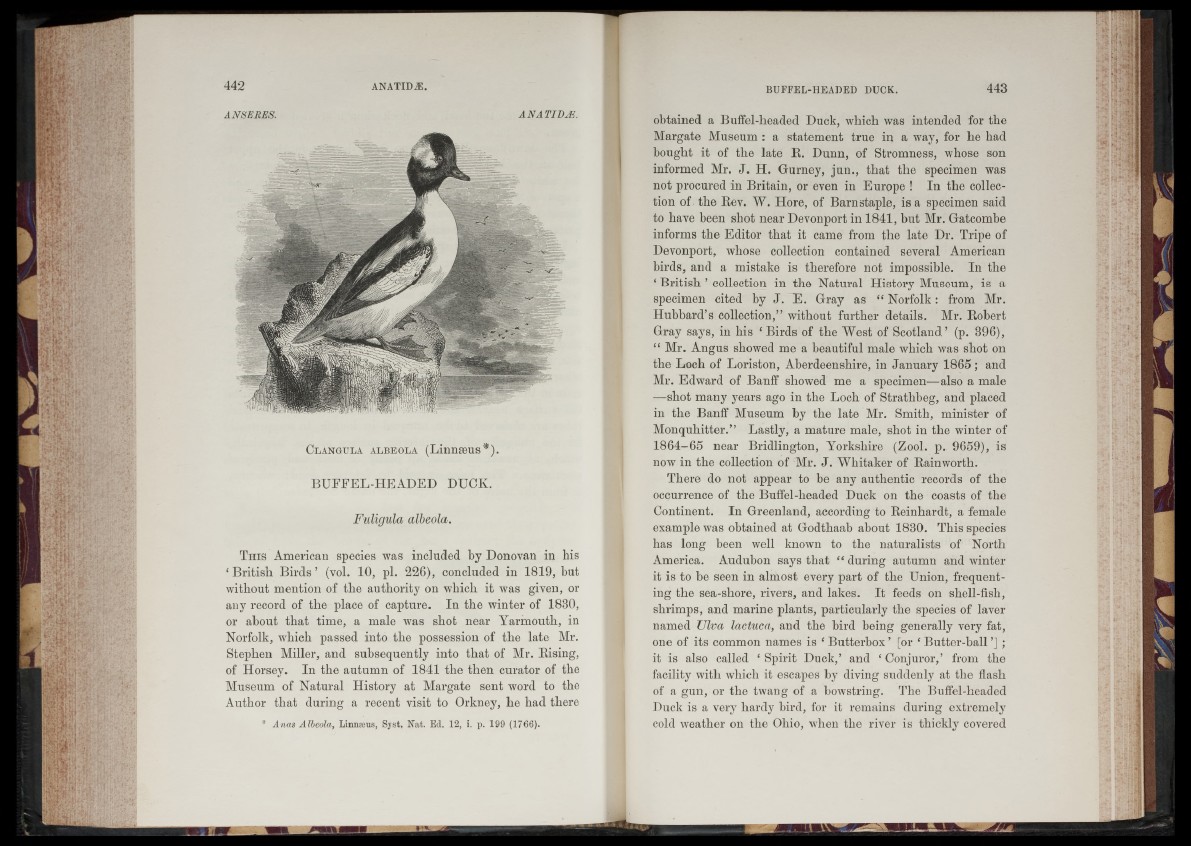
A NS ERES. A NATI DJE.
C langu la a l b eola (Linnseus*).
BUFFEL-HEADED DUCK.
Fuligula albeola.
This American species was included by Donovan in bis
‘ British Birds ’ (vol. 10, pi. 226), concluded in 1819, but
without mention of the authority on which it was given, or
any record of the place of capture. In the winter of 1880,
or about that time, a male was shot near Yarmouth, in
Norfolk, which passed into the possession of the late Mr.
Stephen Miller, and subsequently into that of Mr. Rising,
of Horsev. In the autumn of 1841 the then curator of the
Museum of Natural History at Margate sent word to the
Author that during a recent visit to Orkney, he had there
* Anas Albeola, Linnams, Sjst. Nat. Ed. 12, i. p. 199 (1766).
obtained a Buffel-headed Duck, which was intended for the
Margate Museum : a statement true in a way, for he had
bought it of the late R. Dunn, of Stromness, whose son
informed Mr. J. H. Gurney, jun., that the specimen was
not procured in Britain, or even in Europe ! In the collection
of the Rev. W. Hore, of Barnstaple, is a specimen said
to have been shot near Devonport in 1841, but Mr. Gatcombe
informs the Editor that it came from the late Dr. Tripe of
Devonport, whose collection contained several American
birds, and a mistake is therefore not impossible. In the
‘ British ’ collection in the Natural History Museum, is a
specimen cited by J. E. Gray as “ Norfolk: from Mr.
Hubbard’s collection,” without further details. Mr. Robert
Gray says, in his ‘Birds of the West of Scotland’ (p. 396),
“ Mr. Angus showed me a beautiful male which was shot on
the Loch of Loriston, Aberdeenshire, in January 1865; and
Mr. Edward of Banff showed me a specimen—also a male
—shot many years ago in the Loch of Strathbeg, and placed
in the Banff Museum by the late Mr. Smith, minister of
Monquhitter.” Lastly, a mature male, shot in the winter of
1864-65 near Bridlington, Yorkshire (Zool. p. 9659), is
now in the collection of Mr. J. Whitaker of Rainworth.
There do not appear to be any authentic records of the
occurrence of the Buffel-headed Duck on the coasts of the
Continent. In Greenland, according to Reinhardt, a female
example was obtained at Godthaab about 1830. This species
has long been well known to the naturalists of North
America. Audubon says that “ during autumn and winter
it is to be seen in almost every part of the Union, frequenting
the sea-shore, rivers, and lakes. It feeds on shell-fish,
shrimps, and marine plants, particularly the species of laver
named TJlva lactuca, and the bird being generally very fat,
one of its common names is ‘ Butterbox ’ [or ‘ Butter-ball ’J ;
it is also called ‘ Spirit Duck,’ and ‘ Conjuror,’ from the
facility with which it escapes by diving suddenly at the flash
of a gun, or the twang of a bowstring. The Buffel-headed
Duck is a very hardy bird, for it remains during extremely
cold weather on the Ohio, when the river is thickly covered